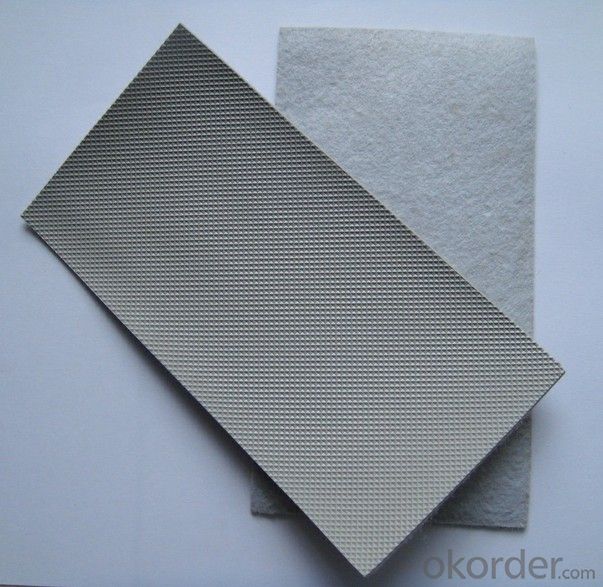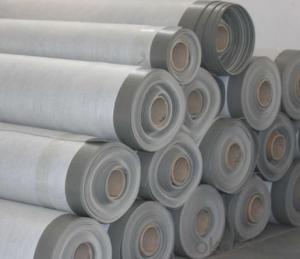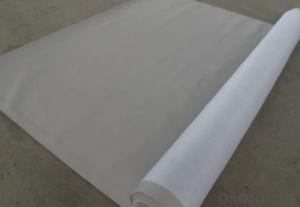PVC Waterproofing Membrane Reinforced Filter Rolls
- Loading Port:
- China main port
- Payment Terms:
- TT OR LC
- Min Order Qty:
- 5000 m²
- Supply Capability:
- 100000 m²/month
OKorder Service Pledge
OKorder Financial Service
You Might Also Like
Features of PVC Waterproofing Membrane:
Excellent anti-aging property.
Puncture- resistant.
Welding construction,
High tensile strength, good elongation, good dimensional stability.
Good plasticity.
It has self-extinguishing from fire property.
Materials surface is smooth, fast color, stain resistance.
More wide, Wastage become less when being used.
Specification of PVC Waterproofing Membrane:
Item | Specification |
Length | 20m |
Width | 1.05m, 2.05m,2.1m |
Thickness | 0.8mm,1.0mm;1.2mm;1.5mm;2.0mm |
Type of PVC Waterproofing Membrane:
N1—Exposed PVC waterproof membrane.
(It is mainly used as details treatment for exposed roof waterproof project)
N2—Non-exposed PVC waterproof membrane.
(It is mainly used as details treatment for non-exposed roof waterproof project)
L1—Exposed PVC waterproof membrane with fabric.
(It is mainly used for exposed roof waterproof project)
L2—Non-exposed PVC waterproof membrane with fabric.
(It is mainly used for non-exposed roof waterproof project)
W1—Exposed reinforced PVC waterproof membrane .
(It is mainly used for steel structure roof exposed waterproof project)
W2—Exposed reinforced PVC waterproof membrane .
(It is mainly used for steel structure roof non-exposed waterproof project)
Use scope of PVC Waterproofing Membrane:
-All kinds of roof .eg steel structure roof, planted roof and so on.
-Underground engineering, such as building basement, subways, tunnels, air Raid shelter, etc.
-Other projects like artificial lake , dam, water reservoir,, grain storehouse, etc.
FAQ of PVC Waterproofing Membrane
a.Can we get some samples before place order?
Answer: We can send the free samples to you by freight collect.
b.How many years can your PVC membrane guarantee?
Answer: We will guarantee the quality for 5 years at least.
c.Which countries you ever export the product?
Answer: We export the PVC membrane to South Africa, Middle east and even European countries.

- Q:Can a waterproofing membrane be used for power plants?
- Yes, a waterproofing membrane can be used for power plants. Waterproofing membranes are commonly used in power plants to protect the structural elements and equipment from water damage and leakage. These membranes are designed to provide a durable, watertight seal that can withstand the harsh conditions and high moisture levels typically found in power plant environments. Additionally, they also help in preventing corrosion and extending the lifespan of the power plant infrastructure.
- Q:Is a waterproofing membrane resistant to hydrostatic pressure?
- A waterproofing membrane possesses resistance to hydrostatic pressure, preventing water from infiltrating the foundation or structure. Its design forms a barrier against water and is engineered to endure and withstand the pressure exerted by water from soil or external sources. This resistance is achieved by utilizing durable and impermeable materials, such as rubberized asphalt or polyethylene, which can withstand the force exerted by water. Additionally, the membrane is installed in a manner that creates a continuous and seamless layer, further enhancing its ability to resist hydrostatic pressure. In summary, a properly installed waterproofing membrane can effectively safeguard a structure from water intrusion, even when faced with significant hydrostatic pressure.
- Q:Can a waterproofing membrane be used on precast stone surfaces?
- Yes, a waterproofing membrane can be used on precast stone surfaces. Precast stone surfaces, like any other concrete or masonry surfaces, are susceptible to water infiltration, which can cause damage over time. Applying a waterproofing membrane on the precast stone surface can help prevent water penetration and protect the stone from moisture-related issues such as cracking, spalling, and efflorescence. The membrane forms a barrier that blocks water from seeping into the stone while still allowing it to breathe and release any trapped moisture. It is important to choose a waterproofing membrane that is compatible with the precast stone material and follow the manufacturer's instructions for proper application.
- Q:Can a waterproofing membrane be used on wood block surfaces?
- Certainly! Waterproofing membranes are a suitable option for safeguarding wood block surfaces. The utilization of a waterproofing membrane on wood block surfaces, like decks or wooden floors, can prove advantageous by shielding against water damage and prolonging the wood's lifespan. These membranes function as a barrier, effectively preventing water from infiltrating the wood and causing deterioration, such as rot, warping, or decay, over time. To guarantee optimal outcomes, it is crucial to select a waterproofing membrane explicitly designed for wood surfaces and adhere to the manufacturer's instructions for application. By doing so, the wood block surface can be adequately protected and maintained, ensuring its resilience and longevity.
- Q:How does a waterproofing membrane handle water infiltration from below?
- A waterproofing membrane is designed to effectively handle water infiltration from below by creating a barrier that prevents water from seeping through the surface it is applied to. The membrane is typically made of a flexible and durable material that can resist water pressure and remain intact. It is installed in such a way that it covers the entire surface area, forming a continuous and impermeable layer. This prevents water from penetrating through the membrane and reaching the underlying structure, effectively protecting it from potential damage caused by water infiltration.
- Q:Can waterproofing membranes be used for planter boxes?
- Yes, waterproofing membranes can be used for planter boxes. Waterproofing membranes are designed to prevent water from penetrating surfaces, and can be applied to various materials such as wood, concrete, or metal. By applying a waterproofing membrane to the inside of a planter box, it can help to protect the material from water damage, prolonging the lifespan of the planter box. This is especially beneficial for wooden planter boxes, as the membrane can prevent the wood from rotting or deteriorating over time. Additionally, the waterproofing membrane can help to retain moisture within the planter box, preventing water from seeping out and ensuring that the plants receive sufficient water for healthy growth. Overall, using waterproofing membranes for planter boxes can help to improve their durability and performance, making them a popular choice for both indoor and outdoor gardening.
- Q:Can a waterproofing membrane be applied on a sloped surface?
- Yes, a waterproofing membrane can be applied on a sloped surface. In fact, applying a waterproofing membrane on a sloped surface can be even more critical than on a flat surface. Sloped surfaces tend to have more water runoff, which can increase the risk of water infiltration and damage to the underlying structure. By applying a waterproofing membrane on a sloped surface, it helps to create a barrier that prevents water from penetrating into the structure and directs it towards drainage systems. However, it is important to ensure that the membrane is properly installed and adhered to the slope to prevent any potential issues such as water pooling or membrane detachment. Additionally, the type of waterproofing membrane used should be suitable for sloped surfaces and have the necessary flexibility to accommodate any movements or shifting that may occur.
- Q:Can a waterproofing membrane be used in steam rooms?
- Yes, a waterproofing membrane can be used in steam rooms. A waterproofing membrane is designed to prevent water infiltration and is commonly used in areas where moisture is present, such as bathrooms, showers, and steam rooms. The membrane acts as a barrier, preventing water vapor from penetrating the underlying structure and causing damage. In steam rooms, where high levels of humidity and moisture are present, using a waterproofing membrane is essential to protect the walls, floors, and other surfaces from water damage and mold growth. It is important to choose a waterproofing membrane that is specifically designed for high moisture environments like steam rooms to ensure proper protection and longevity. Additionally, proper installation and adherence to manufacturer guidelines are crucial for the effectiveness and durability of the waterproofing membrane in a steam room setting.
- Q:Can a waterproofing membrane be used for art installations or sculptures?
- Yes, a waterproofing membrane can be used for art installations or sculptures. Its ability to create a protective barrier against water can help preserve and protect the artwork from moisture damage, making it suitable for outdoor or water-based installations.
- Q:How does a waterproofing membrane handle seismic movements?
- A waterproofing membrane is designed to provide protection against water intrusion and leaks in structures such as buildings, basements, or roofs. While its primary function is to prevent water damage, it also plays a role in handling seismic movements to some extent. Seismic movements, or earthquakes, can cause significant stress and strain on structures, leading to cracks, fissures, or even the complete collapse of buildings. These movements generate intense vibrations and ground motion, which can compromise the integrity of waterproofing systems. In response to seismic movements, a properly installed waterproofing membrane is designed to be flexible and elastic. It can absorb and distribute the energy generated by the ground motion, minimizing the impact on the structure and reducing the likelihood of water infiltration. One way a waterproofing membrane handles seismic movements is through its ability to elongate and stretch. During an earthquake, the membrane can deform and accommodate the movement of the structure without tearing or breaking. This flexibility allows it to maintain its waterproofing capabilities even under extreme conditions. Additionally, waterproofing membranes often incorporate reinforcement layers, such as polyester or fiberglass, to enhance their tensile strength and resistance to tearing. These reinforcement layers help the membrane withstand the dynamic forces exerted during seismic events, ensuring its integrity and preventing water from seeping into the structure. It is important to note that while a waterproofing membrane can handle seismic movements to a certain extent, it is not a substitute for proper structural design and earthquake-resistant construction practices. Structures should be engineered to withstand seismic forces, and waterproofing systems should be installed in accordance with industry standards and guidelines to ensure their effectiveness and durability during earthquakes. In conclusion, a waterproofing membrane can handle seismic movements by being flexible, elastic, and resistant to tearing. It absorbs and distributes the energy generated by seismic events, protecting the structure from water infiltration and minimizing potential damage. However, it is essential to combine proper structural design and construction techniques with a reliable waterproofing system to ensure overall safety and resilience during earthquakes.
1. Manufacturer Overview |
|
|---|---|
| Location | |
| Year Established | |
| Annual Output Value | |
| Main Markets | |
| Company Certifications | |
2. Manufacturer Certificates |
|
|---|---|
| a) Certification Name | |
| Range | |
| Reference | |
| Validity Period | |
3. Manufacturer Capability |
|
|---|---|
| a)Trade Capacity | |
| Nearest Port | |
| Export Percentage | |
| No.of Employees in Trade Department | |
| Language Spoken: | |
| b)Factory Information | |
| Factory Size: | |
| No. of Production Lines | |
| Contract Manufacturing | |
| Product Price Range | |
Send your message to us
PVC Waterproofing Membrane Reinforced Filter Rolls
- Loading Port:
- China main port
- Payment Terms:
- TT OR LC
- Min Order Qty:
- 5000 m²
- Supply Capability:
- 100000 m²/month
OKorder Service Pledge
OKorder Financial Service
Similar products
New products
Hot products
Hot Searches
Related keywords




























